| |
 |
Feature Story |
|
 |
SuperKEKB making headway toward higher luminosity
|
The proposed SuperKEKB electron-positron collider underwent a major design change last March. A team of a hundred experts is moving forward to create the enabling technologies needed to realize the next generation electron-positron collider. |
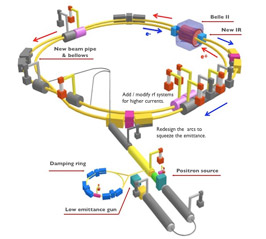
Schematic view of SuperKEKB upgrade. Last March, the team changed their approach to the higher luminosity from high current scheme to small beam size scheme.
|
 |
'Luminosity' is one of the most important values talked of when particle physicists refer to how good a collider performs. One must be careful with this term though; luminosity in accelerator science is not luminosity in the stars. It does not tell you how luminous any matters are, but rather how luminous collision events are. Luminosity refers to the rate of particle collisions, and is a measure of how efficiently an accelerator produces these events. With higher luminosity, interactions produce more particles and particle physicists have more data to use in exploring new area of physics. (Read previous issue for what they are looking for.)
Scientists working at the electron-positron collider known as KEKB at the High Energy Accelerator Research Organization (KEK) have been and are paving new ways forward at the luminosity frontier. Our team of 100 experts has held the world luminosity record since 2001, repeatedly breaking their own records. The current luminosity of 2.11 x 1034 cm-2 s-1 exceeds KEKB's original design luminosity by more than a factor of 2. Now the team is working hard on a major upgrade of their state-of-the-art accelerator. When the upgrade is finished, the new facility will be known as SuperKEKB.
SuperKEKB at one time: The high current option
When SuperKEKB was proposed in 2003, the target luminosity was set to 2 x 1035 cm-2 s-1, about 20 times higher than the KEKB's original design value. Engineering it to higher luminosity involves three things: increasing the beam current, focusing the beams at the interaction point, and/or making the electromagnetic beam-beam interactions small. These correspond to varying values of the beam current, beta-function, and beam-beam parameter, respectively. The team's original approach was two-fold: to increase the beam current and the beam-beam parameter. This approach had been known as the high current option, and proved to be very successful for the SuperKEKB's precursor, KEKB.
In 2007, KEKB's scientists introduced two accelerator cavities called crab cavities, one for the electron ring and one for the positron ring at KEKB. Particles travel in bunches in an accelerator ring. At the interaction point, the beams of electron-bunches and positron-bunches cross at an angle of 1.3 degrees. The newly installed crab cavities kick the head and tail of each bunch of particles so that bunches would make effective head-on collisions at the interaction point. This process is called crab crossing. With these crab cavities installed in the KEKB rings, the team was able to achieve the recent luminosity jump by fifteen percent.
With the success of the high current scheme, KEKB researchers initially thought that they could aim for still higher luminosity by increasing the current, using most of the present configurations of magnets. The target luminosity was then raised up to 8 x 1035 cm-2 s-1. When simulations suggested that they could use the crab crossing to increase the luminosity up to six times higher, the team thought the SuperKEKB's target luminosity was within their reach.
Then, a difficulty arose. The crab crossing effect improved the luminosity, but not as much as the simulation had predicted. "We are running simulations to explore possible scenarios that might keep the value low," explains Dr. Yoshihiro Funakoshi at KEK, the leader of the KEKB commissioning group, "It most likely be because of machine errors that simulations could not take into account."
Aside from this problem, the high current option suffers from other difficulties. They will need to figure out how to cope with phenomena called coherent synchrotron radiation as it will stretch bunches in positron ring. The team also found recently that the beam size at the interaction point in the horizontal direction would have to be much larger than the designed value because of the constraint due to the large magnet size at the interaction region. Both these will result in luminosity drop. While the team continues their effort to overcome these difficulties, the design underwent a major change.
The nano beam design
 |
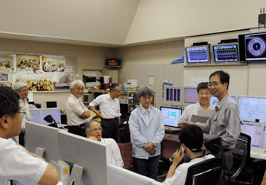
A KEKB leader and beam optics group leader Prof. Haruyo Koiso (center) and the commissioning group leader Dr. Yoshihiro Funakoshi (right) celebrating the new world luminosity record with KEKB scientists and Belle collaborators.
|
In March 2009, the team changed the course of their SuperKEKB design. This change was based on ideas from the Super B Factory, a next-generation electron-positron collider at the National Institute of Nuclear Physics (INFN) in Italy, proposed by a collaboration of former PEP-II scientists at SLAC and Russian physicists. Its target luminosity is as high as 1036 cm-2 s-1, and their base design is called nano beam option. This design takes small beam-size and a large crossing angle at the interaction point, instead of a high current. In other words, they approach higher luminosity by squeezing beams to nanometer-scale, rather than by increasing the beam intensity and the beam-beam parameter.
The brilliance of the nano beam scheme is that it brings out the best of the interaction mechanism. At the interaction point, bunches of particles in the beam can get squeezed to narrower bunches by stronger magnetic fields, but this process saturates at some point because of what is called the 'hourglass effect'. The vertical beam size of beam bunches increase outward from the most focused point so that only very small portion of beam bunch is in focus. This focusing effect will be diluted when beams collide head-on. Why don't we then intersect electron and positron bunches only at the highly focused region of each bunch rather than the entire bunches in order to gain higher luminosity? That led to the nano beam concept.
Using the nano beam scheme in the SuperKEKB design brings a number of advantages. One of the most important advantages is that it is greener. The beam current for this design will be at 4 Ampere for the low energy ring (2.3A for high energy ring), instead of the 9.4 A (4.1A) of the high current scheme. It follows that this scheme will be more economical one, because devices like radiofrequency power sources to sustain high current do not require as extensive extensions as with the high current option. With this design, "we think we will be able to reach luminosity of 8 x 1035 cm-2 s-1," says Funakoshi. "This will be an entirely different approach for SuperKEKB, but seems very promising for the high luminosity we need."
Our entire accelerator team is now working hard on the research and development of each component for the new SuperKEKB design. There are multiple major technological hardships to be overcome by this fall when the team will meet to determine the technological feasibility and reach the final design completion. The final design will change many aspects of the accelerator, and require major upgrades in some area.
The challenges of higher beam current
The first such issues to be resolved are the unfortunate side effects of high beam current. Even with the nano beam scheme, the beam current will increase to twice as much of the present value. Accelerator researchers have known for years that for a high-current electron-positron collider there will be issue of electron-cloud effect in positron ring as well as excessive heating in vacuum chamber due to the strong radiation. Electron clouds form when radiation from accelerating charged particles-called synchrotron radiation-hits the wall surface and kicks out electrons into the chamber. Secondary electrons come out when those electrons hit wall surfaces, contributing to the formation of electron clouds. These electrons disrupt positron beam when they come near the beam. Photon Factory, also at KEK, was the first to observe this effect that heaves up the train of positron bunches. KEKB also confirmed this effect later, and further found a more serious case of a single-bunch instability that vibrates each bunch at much higher frequency.
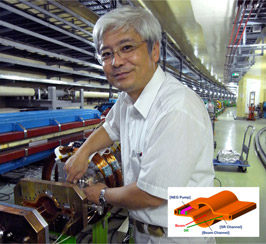
Vacuum group member Dr. Yusuke Suetsugu working at the test vacuum chamber he and his group developed. This Saturn-shaped special chamber has an antechamber for vacuum pump and another antechamber for electron clouds. The former antechamber will eliminate pump ports near beams, and is effective for both electron and positron rings.
|
 |
To counteract such phenomena, the team developed a clever vacuum chamber with two small antechambers, one on the left and one of the right. One antechamber suppresses the formation of electron clouds and the other contains vacuum pumps. They also wrapped the chambers between magnets with solenoid coils to reduce the effect of secondary electrons. According to Dr. Yusuke Suetsugu, a vacuum group member, the research and development for such beam chambers is crucial for SuperKEKB although it became less demanding since the new design, as the beam current is less than a half that of original high current option. The team has already developed several test antechamber from the prototype produced in collaboration with a Russian team in the Budker Institute of Nuclear Physics, and installed them in sections of the KEKB ring.
The electron cloud is one of the central difficulties faced by accelerator scientists in designing new colliders. Other new colliders, such as the currently proposed International Linear Collider (ILC), are faced with the same problem. The ILC teams at KEK, SLAC, and Cornell University collaborate on the research and development of various mitigation techniques. "The collaboration is now exploring a possibility to introduce new and more effective mitigation mechanism inside the bending magnets," says Suetsugu. "We are in good shape for the research and development for this year."
Small, powerful magnets
 |
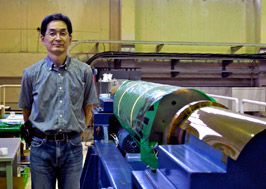
Superconducting magnet group leader Dr. Norihito Ohuchi and the test station he developed for SuperKEKB's original design. He and his group members are now working on more challenging magnets for new nano beam design. The magnets developed and tested for previous design will still be used for sextupole magnets near the interaction region.
|
The next set of challenges involves the superconducting magnets in the interaction region. According to superconducting magnet group leader Dr. Norihito Ohuchi, the new design will need eight strong quadrupole magnets placed deeper in the interaction region to squeeze the beam to nanometer scale. The first hurdle for the group is the design and fabrication of some unusually small quadrupole superconducting magnets whose inner diameters are only 4-8 centimeters. This is one-sixth the diameter of the KEKB quadrupole magnets. Making the magnets this small requires consideration of points that did not matter before. For example, the new nano beam design requires finer magnet current controls to protect magnets from magnet quench due to an excessive heating. Since the current density in the superconductor go beyond 2000A/mm2, the temperature of the magnets will go over 1000 degrees in Kelvin within about 50 milliseconds. Additionally, the accelerator design demands much smaller fabrication errors to acquire a field quality of a few 10-4 with respect to the quadrupole field.
"No one has yet made a superconducting magnet with this small size and the high current density for the interaction region," says Ohuchi. The group is going to construct an R&D magnet by the end of this year and test it in early 2010. The development of this magnet, which will be one of the world's finest superconducting magnets, will be the key to the success of the new design.
Beam optics and short beam lifetime
Another major field of active research is the beam optics. The goal of beam optics research is to find a total solution for creating a beam with ideal properties (shape, emittance and lifetime) for the new nano beam design. This is done by studying the arrangement of magnets along the rings and in the interaction region. The beam optics group uses variety of magnets for different purposes: dipole magnets for bending, quadrupole magnets for beam focusing, and sextupole magnets for correcting beam chromaticity-a parameter that indicates dependence of beam optics on energy deviation. Depending on the arrangement of these magnets they are able to produce a variety of beam parameters.
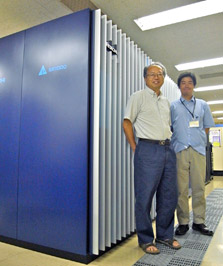
KEKB's simulation group leader Prof. Kazuhito Ohmi (left) and supercomputer group leader at Computing Research Center Dr. Hideo Matsufuru in front of the supercomputer Ohmi uses for his beam-beam collision and beam instability simulations. Ohmi's successful simulation revealed mechanism of electron-cloud induced head-tail instability.
|
 |
"There are many ways those magnets can be arranged in the rings and in the interaction region," says Prof. Haruyo Koiso, a KEKB team leader and the beam optics group leader. "We need much better optics. We are going to explore many more magnet arrangements in the interaction region in great detail."
The most serious issue in the nano beam scheme is the short lifetime of beams. Containing particles inside beam bunch is not easy for variety of reasons. When a quadrupole magnet squeezes a beam, the degree to which the beam can be focused depends on the energy of each particle in the bunch. This causes particles to be dispersed in a beam due to the energy differences. Scientists place sextupole magnets to fix the chromaticity, but the magnetic field created by the sextupole magnets also limits the area inside the pipe that a beam can go through undisturbed. The particles outside of this region can no longer be contained in the beam bunch. Many other sources of nonlinear effects other than the magnetic field due to sextupole magnets can influence on this region, called dynamic aperture, Accelerator scientists analyze the dynamic aperture in three dimensions: horizontal, vertical, and energy dimension. When the dynamic aperture is small, outer particles keep getting lost and the beam's lifetime becomes short.
The problems in dynamic aperture the KEKB researchers face are more acute in nano beam scheme than in high current one, because in nano beam scheme the beam size at the interaction region will be reduced by a factor of ten. The optics group is making its best effort to simulate various possible configurations to complete the conceptual design for the rings and to develop a detailed model for the near interaction point.
Every group in SuperKEKB is now working hard to test and simulate parts of the new nano beam design, including the beam monitors, beam control, beam transport, linac, damping ring, radiofrequency system, and magnet system. Meanwhile the SuplerKEKB team awaits approval for the project from the Japanese government. The fact that the nano beam option is both greener and lower cost option will certainly help.
|
|



